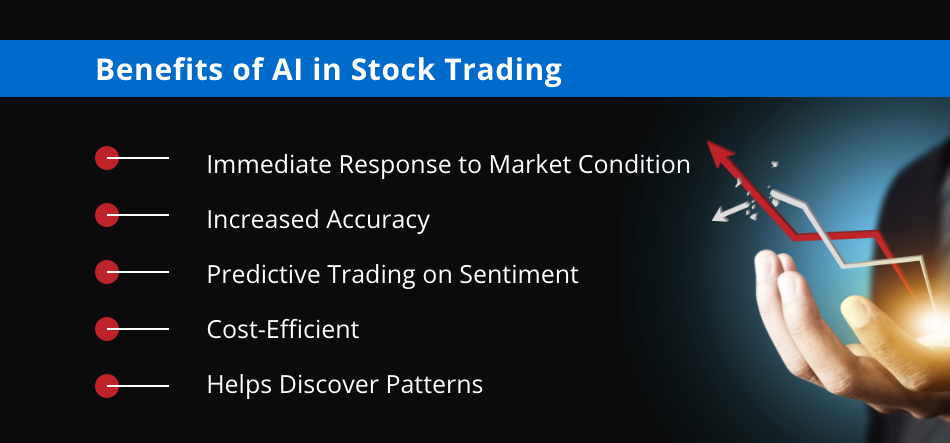20 Recommended Suggestions For Selecting AI Stock Investing Analysis Sites
20 Recommended Suggestions For Selecting AI Stock Investing Analysis Sites
Blog Article
Top 10 Suggestions For Evaluating Ai And Machine Learning Models Used By Ai Stock Predicting/Analyzing Trading Platforms
To get precise valuable, reliable and accurate insights, you need to test the AI models and machine learning (ML). Incorrectly designed models or those that oversell themselves could result in inaccurate predictions as well as financial loss. Here are ten of the most useful ways to evaluate the AI/ML model of these platforms.
1. Learn the purpose and approach of this model
A clear objective: Determine if the model was developed for trading in short-term terms or long-term investments, or sentiment analysis, or risk management.
Algorithm transparency: Make sure that the platform provides the type of algorithms used (e.g. regression or neural networks, decision trees or reinforcement learning).
Customization. Determine whether the model can be adapted to be tailored to your trading strategies, or level of risk tolerance.
2. Evaluate the Model Performance Metrics
Accuracy: Make sure to check the accuracy of predictions made by the model and don't solely rely on this measure, since it may be inaccurate when it comes to financial markets.
Accuracy and recall - Examine the ability of the model to detect true positives and minimize false positives.
Risk-adjusted results: Evaluate whether model predictions result in profitable trading despite accounting risk (e.g. Sharpe, Sortino etc.).
3. Test your model with backtesting
Historical performance: Test the model by using data from historical times to determine how it been performing in previous market conditions.
Out-of sample testing Conduct a test of the model using data it wasn't trained on to prevent overfitting.
Scenario-based analysis involves testing the accuracy of the model in various market conditions.
4. Be sure to check for any overfitting
Overfitting Signs: Look for models that do exceptionally well when they are trained, but not so with data that is not trained.
Regularization Techniques: Examine to see if your platform employs techniques such as regularization of L1/L2 or dropout in order prevent overfitting.
Cross-validation is an essential feature and the platform must use cross-validation when assessing the model generalizability.
5. Examine Feature Engineering
Relevant Features: Look to see whether the model is based on relevant characteristics. (e.g. volume prices, technical indicators, price and sentiment data).
Selected features: Select only those features which are statistically significant. Do not select redundant or irrelevant information.
Dynamic updates of features: Check to see how the model adjusts to the latest features or market changes.
6. Evaluate Model Explainability
Interpretation: Make sure the model has clear explanations of the model's predictions (e.g. SHAP values, the importance of features).
Black-box model: Beware of platforms which use models that are too complicated (e.g. deep neural networks) without describing tools.
User-friendly Insights: Verify that the platform presents actionable insight in a format traders are able to easily comprehend and use.
7. Assess the model Adaptability
Market fluctuations: See whether your model is able to adapt to market changes (e.g. new regulations, economic shifts or black-swan events).
Continuous learning: Check if the model is updated regularly with new data to increase performance.
Feedback loops. Make sure that the model incorporates the feedback from users and real-world scenarios in order to improve.
8. Be sure to look for Bias Fairness, Fairness and Unfairness
Data bias: Make sure the training data is accurate to the market and free from biases (e.g. excessive representation of specific areas or time frames).
Model bias: Make sure that the platform is actively monitoring biases in models and reduces them.
Fairness: Make sure that the model does favor or disfavor specific types of stocks, trading styles, or segments.
9. The Computational Efficiency of a Program
Speed: Check if the model generates predictions in real time, or with a minimum of delay. This is especially important for traders who trade high-frequency.
Scalability - Ensure that the platform can manage huge datasets, many users and not degrade performance.
Resource usage: Verify that the model has been designed to make optimal utilization of computational resources (e.g. GPU/TPU use).
Review Transparency & Accountability
Model documentation: Make sure the platform has a detailed description of the model's design, structure as well as its training process, as well as limitations.
Third-party auditors: Examine whether the model has been subject to an independent audit or validation by an outside party.
Check if there are mechanisms in place to identify errors or failures in models.
Bonus Tips
User reviews and Case Studies User reviews and Case Studies: Read user feedback and case studies to evaluate the actual performance.
Free trial period: Try the model's accuracy and predictability with a demo, or a no-cost trial.
Customer Support: Ensure that the platform has solid technical or model-specific support.
Following these tips can help you assess the AI models and ML models that are available on platforms that predict stocks. You'll be able to determine if they are transparent and reliable. They must also align with your trading goals. Have a look at the most popular ai for investment for blog tips including ai investing platform, ai stock trading app, market ai, ai investing platform, using ai to trade stocks, ai stock market, options ai, ai investment app, ai investing platform, ai investing and more.
Top 10 Tips For Evaluating The Regulatory Compliance Of Ai Stock Predicting/Analyzing Trading Platforms
The regulatory compliance of trading platforms that employ AI to forecast or analyze price movements is a crucial aspect. Compliance ensures that a platform is in compliance to financial regulations and operates within legal frameworks while safeguarding user data. This reduces the risk of financial penalties or legal concerns. Here are 10 best suggestions to evaluate the compliance of these platforms.
1. Verify licensing and registration
Regulators: Confirm that the platform is licensed and registered by the relevant financial regulatory authority (e.g. SEC, FCA, ASIC, etc.) in your nation.
Verify the broker collaboration If your platform has a partnership with brokers and brokers, you need to make sure these brokers are also licensed and regulated.
Public Records: Check out the website of your regulator body for information on the status of registration, past violations and other relevant data.
2. Look for data privacy Compliance
GDPR: Make sure that your website adheres to the General Data Protection Regulation.
CCPA for users living who reside in California ensure that they are in compliance to the California Consumer Privacy Act (CCPA).
Policy on handling data: Make sure you review the platform's privacy policies to know how users' data is collected and stored.
3. Examining anti-money laundering measures
AML policies: Ensure that the platform is able to abide by AML policies that are in place to prevent and detect cash laundering.
KYC procedures: Determine whether the platform supports Know Your Customer (KYC) which validates user identities.
Transparency monitoring You can find out if the platform monitors all transactions for suspicious activity and informs authorities.
4. Verify that you're in compliance with Trading Regulations
Market manipulation: Make sure that the platform includes measures to stop manipulating the market, like spoofing or wash trading.
Types of orders. Verify whether your platform is in compliance with the rules for orders.
The best execution: Ensure that the platform adheres to the highest execution procedures. This will ensure that trades are carried out at the most competitive price.
5. Review the level of Cybersecurity Compliance
Data encryption - Make sure that the platform is using encryption to safeguard data either in transit or when it is at the rest.
Response to incidents. Verify that there is a clearly defined incident response plan for the platform to address cyber attacks and data breaches.
Make sure to check for the certifications.
6. Transparency and Disclosure
Fee disclosure: Ensure that the platform discloses clearly the fees, including hidden costs or other charges.
Risk disclosure: Make sure the platform offers clear risks and disclosures. This is crucial when trading strategies have high leverage or risks.
Performance reporting: Check if the AI model's algorithms are transparent and correctly and accurately reported.
7. Verify that you are in compliance with International Regulations
Cross-border Trading: If you're trading is international it is important to make sure that the platform you use meets all requirements for regulatory compliance in every region.
Tax reporting: Check whether the platform offers tools or reports that can assist users in complying with tax laws (e.g., FIFO rules in the U.S.).
Sanctions compliance - Make sure that the platform complies to international sanctions and does not permit trading only with countries or entities prohibited.
8. Assess Records-keeping and Audit Trails
Transaction records: To meet regulatory and auditing reasons, ensure that the platform has complete records of all transactions.
Logs of user activity: Check if the platform logs users' activities, including transactions, logins, and changes to account settings.
Audit readiness: Find out whether your system can produce the required documentation and logs in the case of an inspection by a regulatory agency.
9. Examine compliance with AI-specific Regulations
Algorithmic trading regulations: If you are using a platform that allows algorithmic trading ensure that it is in compliance with relevant regulatory frameworks like MiFID II or Reg SCI which are in Europe and the U.S.
Fairness and impartiality: Verify whether the platform's AI models are monitored and adjusted to prevent bias.
Explainability - Make sure that the AI platform is able to provide clear and concise explanations regarding AI-driven decisions, predictions, etc. in accordance with certain regulations.
10. Review feedback from users and the history of regulatory compliance
User reviews: Read user reviews to determine the reputation of the platform's regulatory conformity.
Check the regulatory history to see if there are any penalties or fines imposed for violation of regulations.
Third-party Audits: Ensure that the platform has been subjected to third-party audits to ensure that it is in compliance with all applicable regulations.
Bonus Tips:
Legal consultation: Consult an expert on the subject to determine whether your website is compliant with laws.
Trial period: Make use of a no-cost demo or trial to assess the features of the platform that are compliant.
Customer support: Ensure that the platform offers support for compliance-related queries or problems.
With these guidelines, it is possible to assess the degree of compliance with the law between AI stock trading platforms. This will enable you to choose a platform that is operating within the legal framework that will protect your interests. Compliance not only minimizes legal risks, but also increases trust and confidence in the services of the platform. View the top this site about chart ai trading for website recommendations including ai copyright signals, ai in stock market, ai stock trader, trading ai tool, ai stock analysis, free ai stock picker, best ai stocks to buy now, ai stock price prediction, stocks ai, chart ai trading and more.